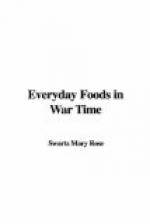Who does not sigh for the fairy table that comes at the pressing of a button? It is invariably laden with the most tempting viands, satisfies beyond words, and disappears when the meal is over, leaving behind no problem of leftovers or planning for the next meal! No money, no work, no thought, only sheer enjoyment. Alas, how different is the world of fact! Even if we have plenty of money we cannot escape from the thought of food today. There is imperative need for saving of food materials; at best there will not be enough to go around, and all the world, ourselves included, will suffer in proportion as we neglect the duty of food conservation. To be economical in the use of food materials according to the program of the Food Administration may, probably will, demand the spending of more money, time, and thought upon food. If we have the money and time to spend, well and good; but if we have not, how shall we do our share in sending more “wheat, meat, sugar and fats to our soldiers, sailors and allies”?
Thousands of people had to practice strict economy before the war began. They have no more money than they had then and the cost of food has increased. Certainly the first duty of everyone is to secure sufficient nourishment to avoid the undermining of health and strength which is sure to follow inadequate food. But we must all remember that it is possible to make a great many changes in diet without altering food value, and that there are few diets which cannot be so rearranged as to give a better nutritive return on the money spent than is usually secured by our haphazard methods of planning meals. Saving of waste is commendable and will go a long way, but this is a kind of passive service; loyal citizens ought to be active participants in the food conservation movement, which is a movement to distribute food in the way which shall promote the efficiency of our allies and ourselves in this world upheaval. To do this without increasing the cost of one’s diet requires a careful study of the situation. No one can give precise rules as to how it shall be done, but perhaps a few suggestions as to the underlying principles will help in determining a dietary plan which shall be economical and still in line with the general policy.
The same nutritive essentials must be supplied whether the cost of the diet be much or little. A moderately active man needs some 3,000 calories per day whether his activity be playing golf or working on a farm; whether his board bill be $3.00 a day or $3.00 a week. In both cases there must be suitable kinds and amounts of protein-bearing food, of other “building materials,” and those substances which directly or indirectly affect the smooth running of the body machinery; nevertheless, these two diets, closely alike in nutritive value, may be very dissimilar in their superficial appearance. For instance, all the nutritive requirements may be met in a ration composed of three food materials, as milk, whole wheat




